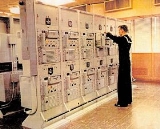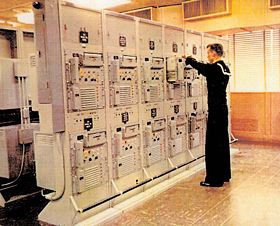
KW-26
Encyclopedia

Cryptography
Cryptography is the practice and study of techniques for secure communication in the presence of third parties...
used by the U.S. Government and, later, by NATO countries. It was developed in the 1950s by the National Security Agency
National Security Agency
The National Security Agency/Central Security Service is a cryptologic intelligence agency of the United States Department of Defense responsible for the collection and analysis of foreign communications and foreign signals intelligence, as well as protecting U.S...
(NSA) to secure fixed teleprinter
Teleprinter
A teleprinter is a electromechanical typewriter that can be used to communicate typed messages from point to point and point to multipoint over a variety of communication channels that range from a simple electrical connection, such as a pair of wires, to the use of radio and microwave as the...
circuits that operated 24 hours a day. It used vacuum tube
Vacuum tube
In electronics, a vacuum tube, electron tube , or thermionic valve , reduced to simply "tube" or "valve" in everyday parlance, is a device that relies on the flow of electric current through a vacuum...
s and magnetic core logic, replacing older systems, like SIGABA
SIGABA
In the history of cryptography, the ECM Mark II was a cipher machine used by the United States for message encryption from World War II until the 1950s...
and the British 5-UCO
5-UCO
The 5-UCO was an on-line one-time tape Vernam cipher encryption system developed by the UK during World War II for use on teleprinter circuits. During the 1950s, it was used by the UK and US for liaison on cryptanalysis....
, that used rotors and electromechanical relays.
A KW-26 system (transmitter or receiver) contained over 800 cores and approximately 50 vacuum-tube driver circuits, occupying slightly more than one half of a standard 19-inch rack
19-inch rack
A 19-inch rack is a standardized frame or enclosure for mounting multiple equipment modules. Each module has a front panel that is wide, including edges or ears that protrude on each side which allow the module to be fastened to the rack frame with screws.-Overview and history:Equipment designed...
. Most of the space in the rack and most of the 1 kW input power were required for the special-purpose vacuum tube circuits needed to provide compatibility with multiple input and output circuit configurations. The military services' requirements for numerous modes and speeds significantly increased costs and delayed delivery. NSA says it is doubtful that more than three or four of the possible configurations were ever used.
The KW-26 used an NSA-developed encryption algorithm based on shift register
Linear feedback shift register
A linear feedback shift register is a shift register whose input bit is a linear function of its previous state.The most commonly used linear function of single bits is XOR...
s. The algorithm produced a continuous stream of bit
Bit
A bit is the basic unit of information in computing and telecommunications; it is the amount of information stored by a digital device or other physical system that exists in one of two possible distinct states...
s that were xored with the five bit Baudot
Baudot code
The Baudot code, invented by Émile Baudot, is a character set predating EBCDIC and ASCII. It was the predecessor to the International Telegraph Alphabet No 2 , the teleprinter code in use until the advent of ASCII. Each character in the alphabet is represented by a series of bits, sent over a...
teleprinter code to produce ciphertext
Ciphertext
In cryptography, ciphertext is the result of encryption performed on plaintext using an algorithm, called a cipher. Ciphertext is also known as encrypted or encoded information because it contains a form of the original plaintext that is unreadable by a human or computer without the proper cipher...
on the transmitting end and plaintext
Plaintext
In cryptography, plaintext is information a sender wishes to transmit to a receiver. Cleartext is often used as a synonym. Before the computer era, plaintext most commonly meant message text in the language of the communicating parties....
on the receiving end. In NSA terminology, this stream of bits is called the key
Key (cryptography)
In cryptography, a key is a piece of information that determines the functional output of a cryptographic algorithm or cipher. Without a key, the algorithm would produce no useful result. In encryption, a key specifies the particular transformation of plaintext into ciphertext, or vice versa...
. The information needed to initialize the algorithm, what most cryptographers today would call the key, NSA calls a cryptovariable. Typically each KW-26 was given a new cryptovariable once a day.

Fill device
A fill device is an electronic module used to load cryptographic keys into electronic encryption machines. Fill devices are usually hand held and battery operated....
(CFD), for loading the cryptovariable. It used a Remington Rand
Remington Rand
Remington Rand was an early American business machines manufacturer, best known originally as a typewriter manufacturer and in a later incarnation as the manufacturer of the UNIVAC line of mainframe computers but with antecedents in Remington Arms in the early nineteenth century. For a time, the...
(UNIVAC) format punched card
Punched card
A punched card, punch card, IBM card, or Hollerith card is a piece of stiff paper that contains digital information represented by the presence or absence of holes in predefined positions...
(45 columns, round holes). The operator inserted the daily key card into the CFD and closed the door securely, locking the card in place. Decks of cards were created by NSA and sent by courier. The cards were strictly accounted for.
Because the KW-26 used a stream cipher
Stream cipher
In cryptography, a stream cipher is a symmetric key cipher where plaintext digits are combined with a pseudorandom cipher digit stream . In a stream cipher the plaintext digits are encrypted one at a time, and the transformation of successive digits varies during the encryption...
, if the same key card was ever used twice, the encryption could be broken.
Stream cipher attack
Stream ciphers, where plaintext bits are combined with a cipher bit stream by an exclusive-or operation , can be very secure if used properly. However they are vulnerable to attack if certain precautions are not followed:*keys must never be used twice...
To prevent re-use, the card was automatically cut in half upon reopening the CFD. As the units aged, the card reader contacts became less dependable, and operators resorted to various tricks, such as hitting the card reader cover with a screwdriver, to get them to work properly.Card readers were cleaned and the spring loading of the contacts checked as part of the routine maintenance of the device.
Because the KW-26 sent a continuous stream of bits, it offered traffic-flow security. Someone intercepting the ciphertext stream had no way to judge how many real messages were being sent, making traffic analysis
Traffic analysis
Traffic analysis is the process of intercepting and examining messages in order to deduce information from patterns in communication. It can be performed even when the messages are encrypted and cannot be decrypted. In general, the greater the number of messages observed, or even intercepted and...
impossible. One problem with the KW-26 was the need to keep the receiver and transmitter units synchronized. The crystal controlled clock in the KW-26 was capable of keeping both ends of the circuit in sync for many hours, even when physical contact was lost between the sending and receiving units. This capability made the KW-26 ideally suited for use on unreliable HF radio circuits. However, when the units did get out of sync, a new key card had to be inserted at each end. The benefit of traffic-flow security was lost each time new cards were inserted. In practice, operational protocol led to the cards being replaced more often than was desirable to maintain maximum security of the circuit. This was especially so on radio circuits, where operators often changed the cards many times each day in response to a loss of radio connectivity. In any case, it was necessary to change the cards at least once per day to prevent the cypher pattern from repeating.
Early KW-26 units protected the CRITICOMM network, used to protect communications circuits used to coordinate signals intelligence gathering. The initial production order for this application, awarded to Burroughs in 1957, was for 1500 units. Other services demanded KW-26's and some 14000 units were eventually built, beginning in the early 1960s, for the U.S. Navy, Army, Air Force, Defense Communications Agency, State Department and the CIA. It was provided to U.S. allies as well.
When the USS Pueblo
USS Pueblo (AGER-2)
USS Pueblo is an American ELINT and SIGINT Banner-class technical research ship which was boarded and captured by North Korean forces on January 23, 1968, in what is known as the Pueblo incident or alternatively as the Pueblo crisis or the Pueblo affair. Occurring less than a week after President...
was captured by North Korea
North Korea
The Democratic People’s Republic of Korea , , is a country in East Asia, occupying the northern half of the Korean Peninsula. Its capital and largest city is Pyongyang. The Korean Demilitarized Zone serves as the buffer zone between North Korea and South Korea...
in 1968, KW-26's were on board. In response, the NSA had modifications made to other units in the field, presumably changing the crypto algorithm in some way, perhaps by changing the shift register feedback taps. Starting in the mid-1980s, the KW-26 system was decommissioned by NSA, being replaced by the more advanced solid-state data encryptor, TSEC/KG-84
KG-84
The KG-84A and KG-84C are encryption devices developed by the U.S. National Security Agency to ensure secure transmission of digital data. The KG-84C is a Dedicated Loop Encryption Device , and both devices are General-Purpose Telegraph Encryption Equipment...
.

